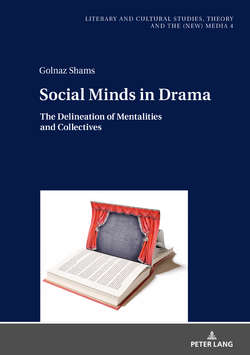Social Minds in Drama

Реклама. ООО «ЛитРес», ИНН: 7719571260.
Оглавление
Golnaz Shams. Social Minds in Drama
About the author
About the book
This eBook can be cited
Acknowledgements
Table of Contents
Chapter 1 Introduction. 1.1 Topic and Major Questions
1.2 (Intermentality and) Social Minds
1.3 In What Way Does This Study Go beyond Previous Studies?
1.4 Methodology and Approach
1.5 My Corpus
1.6 Structure of the Book
Chapter 2 Theoretical Background
2.1 From Classical Narratology to Postclassical and Cognitive Narrative Studies
2.2 Alan Palmer’s Construction of Fictional Minds and Intermentality. 2.2.1 Palmer and His Work
2.2.2 Palmer in the Context of Cognitivist Ideas
2.2.3 Palmer’s Intermentality
2.3 The Status of Drama within Narrative Studies
Chapter 3 Character and Consciousness in Drama
3.1 Character and Characterisation in Theatre Studies So Far
3.2 Character and Consciousness in the Embedded and Doubly Embedded Narrative of Playscripts
3.3 Character and Consciousness in the Stage Directions
3.4 Character and Consciousness in the Introductory and Explanatory Passages
3.5 Conclusion
Chapter 4 Mentalities and Fictional Minds I
4.1 Introduction
4.2 Introductory and Explanatory Passages
4.2.1 Introductory and Explanatory Passages in Ibsen
4.2.2 Introductory and Explanatory Passages in Wilde
4.2.3 Introductory and Explanatory Passages in Shaw
4.3 Stage Directions
4.3.1 Stage Directions in Ibsen
4.3.2 Stage Directions in Wilde
4.3.3 Stage Directions in Shaw
4.4 Conclusion
Chapter 5 Mentalities and Fictional Minds II
5.1 Introduction
5.2 Embedded Narratives
5.2.1 Embedded Narratives in Ibsen
5.2.2 Embedded Narratives in Wilde
5.2.3 Embedded Narratives in Shaw
5.3 Doubly Embedded Narratives
5.3.1 Doubly Embedded Narratives in Ibsen
5.3.2 Doubly Embedded Narratives in Wilde
5.3.3 Doubly Embedded Narratives in Shaw
5.4 Conclusion
Chapter 6 Intermentality and Group Formation in Ibsen
6.1 Introduction
6.2 Group Formation and Intermentality in A Doll House
6.3 Group Formation and Intermentality in The Wild Duck
6.4 Group Formation and Intermentality in Hedda Gabler
6.5 Group Formation and Intermentality in The Master Builder
6.6 Ibsen’s Plays in Criticism
6.7 Conclusion
Chapter 7 Intermentality and Group Formation in Wilde
7.1 Introduction
7.2 Group Formation and Intermentality in Lady Windermere’s Fan
7.3 Group Formation and Intermentality in A Woman of No Importance
7.4 Group Formation and Intermentality in An Ideal Husband
7.5 Group Formation and Intermentality in The Importance of Being Earnest
7.6 Wilde’s Plays in Criticism
7.7 Conclusion
Chapter 8 Intermentality and Group Formation in Shaw
8.1 Introduction
8.2 Group Formation and Intermentality in Arms and the Man
8.3 Group Formation and Intermentality in Candida
8.4 Group Formation and Intermentality in You Never Can Tell
8.5 Group Formation and Intermentality The Man of Destiny
8.6 Shaw’s Plays in Criticism
8.7 Conclusion
Chapter 9 Summary and Outlook
Appendix130. 1 A Doll’s House
2 The Wild Duck
3 Hedda Gabler
4 The Master Builder
5 Lady Windermere’s Fan
6 A Woman of No Importance
7 An Ideal Husband
8 The Importance of Being Earnest
9 Arms and the Man
10 Candida
11 You Never Can Tell
12 The Man of Destiny
Bibliography. Primary Texts
Secondary Texts
Отрывок из книги
Golnaz Shams
Social Minds in Drama
.....
Chapter 9 Summary and Outlook
Appendix
.....